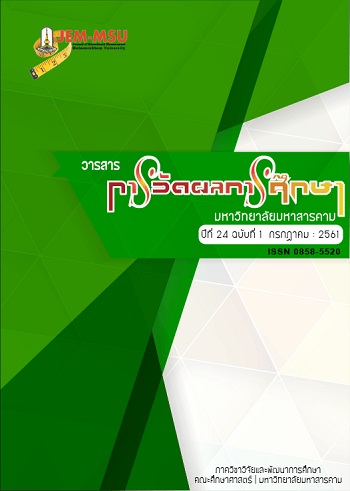THE DEVELOPMENT OF FOUR-TIER DIAGNOSTIC TEST AND MODEL FOR REDUCING MISCONCEPTIONS IN CALCULUS 1 OF HIGH VOCATIONAL CERTIFICATE STUDENTS
Main Article Content
Abstract
This study had four objectives: 1) to develop four - tier diagnostic test in calculus 1
2) to study the cause of the students’ misconceptions in calculus 1 3) to develop the model
for reducing misconceptions and 4) to compare misconceptions in calculus 1 of the students
in the procedure for changing misconceptions in accordance with the model developed by
the researcher with the students in the normal procedure for changing conceptions. The
samples used in the study were the first year high vocational certificate industrial students of
technical colleges in the Northeast under the Office of the Vocational Education Commission
in the academic year 2015. The samples are divided into 3 groups: 1) The first group used in
construction of the diagnostics tests instrument was the industrial students by means of
cluster random sampling with 3,239 students from 12 colleges. 2) The second group used
experimental group was electrician of Sakon Nakhon Technical College with 36 students in
one classroom while the controlled group was the electrician of Udorn Thani Technical
College with 33 students in one classroom. The both groups had the same characteristics
and were sampled by purposive sampling. 3) The third group used in was finding the 240
students of Sakon Nakhon Technical College who used to study calculus 1 in 8 classrooms
sampled by purposive sampling. The instruments used in this study were 19 sets of fours-tier
diagnostic test with 491 items by means selected from 645 items and each test with 18-32
items. The test obtained by developing 5 set of completion tests each with 15 items. Finding
quality of the fours-tier diagnostic test would find only the first tier and third tier questions
which the first tier was the question that asked the conceptual content of subject and the
third tier was the question that asked the reason for choosing in the first tier choice. The
second and fourth tier questions were asked about the level of confidence in the first and
third questions respectively to find difficult, discriminating power of items and the reliability
of the tests.
The Result of the study was as follow:
1. From construction the 19 tests of fours-tier diagnostic test with 27-36 items and
total in 645 items, the researcher got items that had quality with 19 tests with 18-32 items
and total in 491 items. These items of the first tier question had a difficulty value of the
items at 0.20-0.80, the discrimination was at 0.20-0.80 and the reliability value was at 0.72-
0.89. But the difficulty value of the third tier question was at o.20-0.76. The discrimination
was at 0.20-0.82 and the reliability value was at 0.71-0.89.
2. The cause to have misconception of the students in calculus 1 was found that
they had misconceptions in the definition, symbols, problem solving procedure and formula
rule at 73.31 % – 78.77 %. There were confident levels of answering the one -tier question
lower than confident level at 88.05 % - 91.49 % by the wrong reason in the answer at 74.80
% - 89.15 % and there were confident levels of answering the third -tier question lower than
confident level at 88.05 % - 91.49 %.
3. The developed model for reducing misconceptions in calculus 1 consisted of 5
steps : 1) to survey the students’ backgrounds 2) to design the activities 3) knowledge
conforming 4) assessment for learning 5) to apply. On the whole, it was found that the
model was suitable at the highest level and the specialists had the consistent agreement
that the factors in the model were consistent, supportable and related to one another.
4.The result in comparison of the students’ misconceptions in calculus 1 for
changing conceptions in accordance with the model developed by the researcher with the
students in normal procedure was found that the developed mean of the students in the
experimental group was higher than the controlled group with statistical significant (p<0.50).
The mean of effect size had big size ( = 2.30, x x 1 2 9.26, CI=7.74-10.79), showed that
students of experimental group had their reduced misconceptions.
Article Details
The content and information contained in the published article in the Journal of Educational Measurement Mahasarakham University represent the opinions and responsibilities of the authors directly. The editorial board of the journal is not necessarily in agreement with or responsible for any of the content.
The articles, data, content, images, etc. that have been published in the Journal of Educational Measurement Mahasarakham University are copyrighted by the journal. If any individual or organization wishes to reproduce or perform any actions involving the entirety or any part of the content, they must obtain written permission from the Journal of Educational Measurement Mahasarakham University.
References
2. พงศ์สนิท สนิทวงศ์. (2518). แคลคูลัสและเรขาคณิตวิเคราะห์. กรุงเทพฯ: ไทยวัฒนาพานิช.
3. สถาบันส่งเสริมการสอนวิทยาศาสตร์และเทคโนโลยี (สสวท). (2555). การวัดผลแลประเมินผลคณิตศาสตร์.
กรุงเทพฯ: ซีเอ็ดยูเคชั่น.
4. สมโภชน์ อเนกสุข. (2553). วิธีการทางสถิติส าหรับการวิจัย. พิมพ์ครั้งที่ 4. ชลบุรี: คณะศึกษาสาสตร์
มหาวิทยาลัยบูรพา.
5. อัมพร ม้าคนอง. (2557). คณิตศาสตร์ส าหรับครูมัธยม. กรุงเทพฯ: ส านักพิมพ์แห่งจุฬาลงกรณ์มหาวิทยาลัย.
6. Cohen, J. (1988). Statistical Power Analysis for the Behavioral Sciences. NJ: Lawerence
Erlbaum.
7. Keeves, J.P. (1997). Education research, methodology, and measurement an international
handbook. Oxford: Pergamon Press.
8. Parameswaran. (2007). Obstacles to student’s understanding of the limit concept. [Online].
Available from: https://keynote onference-sevices.net/resources/…/cerme10-
0231.pdf.
9. Salas, S. L, & Hille, E. (1971). Calculus one and several variables. (3rd ed).
New York: John Wiley & Sons.
10.Tall, D.O. (1993). Functions and Calculus. [Online]. Available from:
http:// citeseerx.ist.pu.edu/viewdee/download? doi=10.1.1.377.207
11. Treagust, D. F. (1988). Development and use of diagnostic tests to evaluate student’
misconceptions in science. International Journal of science education, 10(2), 159-169.
12. Uygur & Ozdas. (2005). Calculus student’ understanding of the derivative in relation to the
vertex of a quadratic function. [Online]. Available from:
http:// scholarworks.gsu.edu/math-diss.


